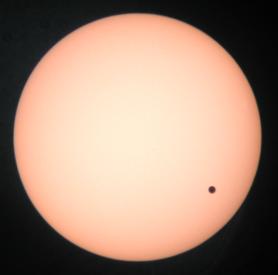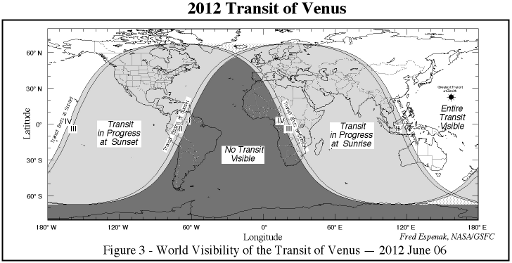« Reading List: Survivors | Main | Reading List: The Saturn V F-1 Engine »
Thursday, January 12, 2012
Heads up! Transit of Venus, 2012 June 5-6th
 One of the rarest of celestial spectacles is the transit of the planet Venus in
front of the disc of the Sun as viewed from the Earth. Indeed, this event did
not occur at all in the twentieth century and takes place only twice in the twenty-first,
the first of which, on June 8th, 2004, you've already missed.
So it's either catch the big show on June 5–6th of 2012 or plan to hang in there
until the next transit of Venus on the 11th of December 2117.
Fortunately, the 2012 transit of Venus occurs near the June solstice, when the Earth's
northern hemisphere is tilted the most toward the Sun, and since the southern
hemisphere is mostly water and ice, the vast majority of the human population
will, given clear skies, be able to observe this celestial show. With the exception of
people in western Africa, the west of Spain, Portugal, the eastern three quarters
of South America, and Antarctica, the transit will be visible, although to many
viewers the transit (which lasts about six hours) will already be in progress at
sunrise or still be in progress at sunset. So while you may not be able to observe
the whole thing, unless you happen to be in one of the sadly deprived regions
this time, you'll at least be able to see Venus as “a spot, not a dot”
crossing the disc of the Sun. The following map courtesy of
Fred
Espenak and NASA/GSFC shows visibility of the transit. As long as you're
not in the darkest shaded area, you'll be able to see it if the weather cooperates.
One of the rarest of celestial spectacles is the transit of the planet Venus in
front of the disc of the Sun as viewed from the Earth. Indeed, this event did
not occur at all in the twentieth century and takes place only twice in the twenty-first,
the first of which, on June 8th, 2004, you've already missed.
So it's either catch the big show on June 5–6th of 2012 or plan to hang in there
until the next transit of Venus on the 11th of December 2117.
Fortunately, the 2012 transit of Venus occurs near the June solstice, when the Earth's
northern hemisphere is tilted the most toward the Sun, and since the southern
hemisphere is mostly water and ice, the vast majority of the human population
will, given clear skies, be able to observe this celestial show. With the exception of
people in western Africa, the west of Spain, Portugal, the eastern three quarters
of South America, and Antarctica, the transit will be visible, although to many
viewers the transit (which lasts about six hours) will already be in progress at
sunrise or still be in progress at sunset. So while you may not be able to observe
the whole thing, unless you happen to be in one of the sadly deprived regions
this time, you'll at least be able to see Venus as “a spot, not a dot”
crossing the disc of the Sun. The following map courtesy of
Fred
Espenak and NASA/GSFC shows visibility of the transit. As long as you're
not in the darkest shaded area, you'll be able to see it if the weather cooperates.

Posted at January 12, 2012 20:19